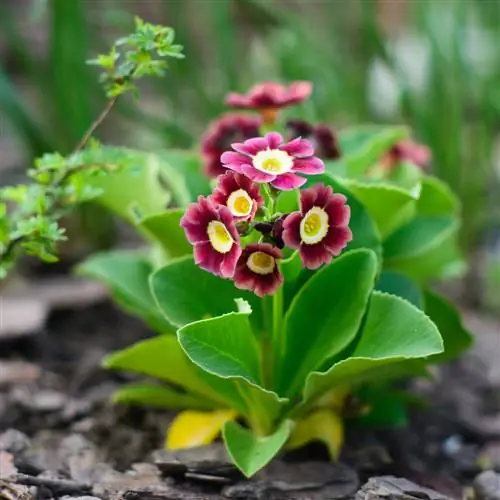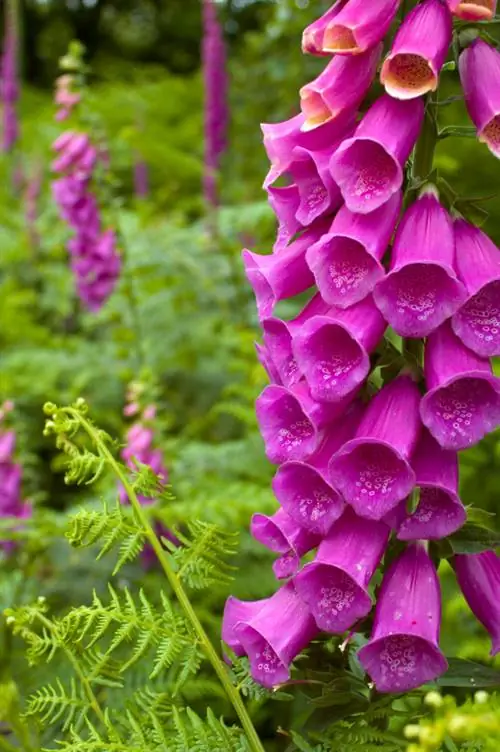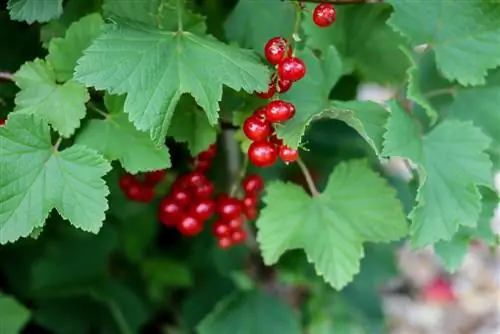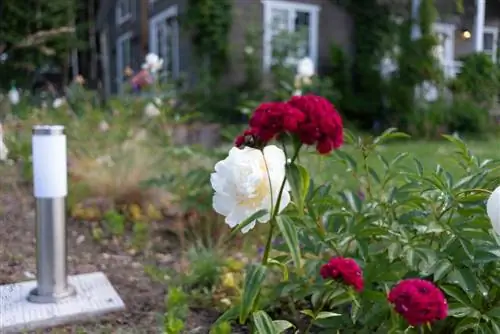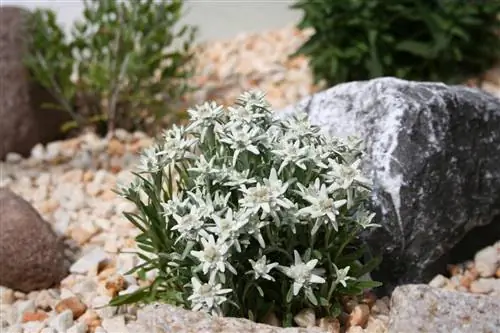- Author admin [email protected].
- Public 2023-12-16 16:46.
- Last modified 2025-01-23 11:21.
Auricles have been forgotten. They were once considered favorite collector's items among the upper echelons of society. Throughout its history, numerous plant lovers have dedicated themselves to breeding new varieties. This resulted in shapes that are being rediscovered today.

What should you know about caring for and propagating auricles?
Auricles, also known as Primula auricula, are evergreen, perennial plants from the primrose family that occur in mountainous regions. They are hardy and require well-drained, calcareous soil and a partially shaded location. Auricles can be propagated by division or sowing and are suitable for rock gardens, bed edges or container planting.
Origin
Auricula is a plant species with the Latin name Primula auricula, which belongs to the primrose genus. This plant is found in the mountainous regions. Their area extends over the western part of the Northern Limestone Alps including the Jura. It occurs in the Black Forest and has some relict locations in the Bavarian Alpine foothills. Outside Germany, their area extends from the Pyrenees across Switzerland to Vorarlberg and Tyrol in Austria. Auricles grow wild in southwestern Poland and Slovakia.
Auricules occur on calcareous soils and rubble. They occur in crevices and reach altitudes of up to 2,900 meters. Wild forms that came from the mountain regions of Switzerland, Austria and Bavaria were discovered as early as the late 15th century. Cultivated in Nuremberg for the century. The plants cultivated today as auricles come from a natural cross between two wild-growing primrose species. Primula auricula and Primula hirsuta formed the bastard auricles, Primula × pubescens. This form gave rise to a wide range of cultivated forms, which are collectively offered under the name Garden Auricula.
Growth
Primrose species grow as evergreen plants that retain their leaves in winter. They are perennial and herbaceous. Auricles reach heights of between five and 25 centimeters. This makes the wild auricle the largest primrose in the Alpine region. Their plant parts are covered by a delicate mealy dust.
Bloom
Auricles bear umbellate inflorescences composed of four to twelve flowers. The individual flowers exude a more or less intense scent. They have a hermaphrodite structure and develop diameters between 15 and 25 millimeters. Their fivefold structure leads to a radial symmetry.
The flowers have a double perianth, which consists of five sepals and petals each. The sepals are fused together and form a bell. Five petals are fused at their base to form a corolla tube. It ends in five crown lobes spread apart. The calyx is about half as long as the corolla tube.
Flower color
The wild-growing Primula auricula develops light yellow petals, while Primula hirsuta bears bright pink to purple flowers. The color palette of the cultivated forms is much more extensive. It ranges from white to yellow and pink to various shades of red and purple. They bloom between April and July.
Fruit
The fruits of the wild forms ripen between September and October. In cultivated plants, the time of fruit ripening is variable. Auricles develop spherical capsule fruits, which open in the final stage of maturity and scatter the seeds. The capsules contain numerous elongated seeds that have a brown-black surface. They are light germinators that require a cold stimulus to germinate. The seeds spread through wind and rain.
leaves
Auricules develop a basal rosette with simply structured leaves. They develop a length of between two and 12 centimeters. The leaf blades are narrow and obovate to lanceolate. The leaf edge is entire or notched and partly has a cartilage edge.
The leaves serve to store water, making them appear tough and fleshy. The leaf surface is gray-green in color and is covered by a shiny waxy layer that serves as protection against evaporation. There are numerous short glandular hairs on the leaf blade, which, like the wax layer, counteract excessive loss of fluid.
Usage
The primrose varieties are associated with the typical cottage garden. Here the herbaceous plants grow on the edges of the beds, where they can spread unhindered. Auricles form magnificent carpets in the right location. As heralds of spring, they bring the rock garden back to life after winter. Together with other plants from the mountain regions, the auricle conjures up a wildly romantic mountain backdrop in the alpine garden.
These old garden treasures fit the alpine garden:
- Alpine gentian (Gentiana alpina) with its intense blue flowers
- Scented violet (Viola odorata) with bright purple flowers
- Christmas roses (Helleborus niger) as white flowers
- Vineyard tulips (Tuipa sylvestris) with nodding flower bells
The beauties are often displayed in so-called auricle theaters. This performance is based on a historical model. Wooden étagères or shelves served as showcases, the walls of which were painted black. They were equipped with mirrors and decorated with curtains. Today the old Aurikel varieties are traditionally offered in clay pots with an official-looking real wood label.
Poisonous
All parts of the auricle plant are poisonous. The main active ingredient is saponins, which are highly concentrated in the root. The plants also contain various oils and traces of esters. Make sure children and pets do not accidentally consume the flowers and leaves.
Skin contact can cause dermatitis. An allergen is responsible for the allergic reactions. Repeated touching reduces the sensitivity of the skin. The reactions are weaker. If you are unsure, you should wear gloves as a precaution.
Location
The breathtaking alpine plants prefer a bright location in a protected location. The leaves do not like direct midday sun. Make sure you choose a partially shaded location. The plants are adapted to dry growing locations.
Earth
The substrate should be highly permeable, as the delicate roots cannot tolerate waterlogging. Mix sand or grit into the soil to improve its structure. Auricules feel comfortable on neutral to slightly calcareous soil. Place the alpine plants on gravel or calcareous rock to ensure optimal conditions for them.
Planting time
Auricles can be planted between spring and autumn. If you plant the plants outdoors between September and October, they can fully develop their flowers the following spring. The alpine plants do not require much space. There is space for up to 25 copies per square meter.
Propagation
You can propagate garden auricles by division, by completely digging up the root ball and freeing the roots from the soil. The roots are divided in the visible separation areas. Use a sharp and sanitized knife to get a clean cut. Allow the cut surfaces to dry briefly and plant the sections in a prepared planting hole.
The ideal time for propagation is between September and October. It is recommended if the auricle has developed dense tissue. This method allows you to rejuvenate the plant and further cultivate the characteristics of the parent species.
Sowing
Alpine plants can be propagated generatively through seeds. With this method you need to have some patience. The offspring may develop different flower colors. They combine the genetic material of two parent plants.
You can sow the collected seeds in the same year after flowering. Cover the seeds with a very thin layer of soil to protect them from drying out. After a cold stimulus, the seeds begin to germinate quickly. Exposure to cold at night is enough to encourage the seeds to grow. With this method there is a risk that the plants will not develop quickly enough until winter. You then need antifreeze.
Advance
As an alternative to sowing in autumn, you can bring the seeds forward in January. Use potting soil mixed with sand, perlite or gravel as a substrate. Lightly moisten the soil and sprinkle the seeds evenly on the substrate. Place the planter in a bright place with temperatures between 18 and 20 degrees Celsius and check the moisture of the substrate daily.
In the pot
Auricles are perfect for planting in containers because they don't require a lot of space. Choose a pot with a diameter of twelve centimeters. It ensures you better control of the water supply. You can also easily relocate the small pot.
The bucket should be at least 20 centimeters deep so that the taproots can spread optimally. It should have a drainage hole to ensure water drainage. Do not place the pot on a saucer as the water should not pool. To prevent waterlogging, you can place drainage at the bottom of the bucket.
Giessen
During the growth phase, the substrate should not dry out completely. The plant can cope with short dry spells. Prolonged dryness or waterlogging causes problems for them. If necessary, water the plant sparingly with rainwater. They tolerate irrigation water with a higher lime content.
How to water auricles correctly:
- Provide small amounts of water more frequently during the summer
- drain excess water
- let it dry out before winter
- stop watering in winter
Fertilize
The primrose species do not need to be fertilized because they draw their nutrients from the substrate. Avoid adding compost to avoid over-fertilization. You can give some orchid fertilizer in low concentration immediately after flowering. This stimulates growth.
Transplanting
If you grow your auricles in a pot, you should repot the plant every two to three years. It is not necessary to use a larger bucket. You can continue to use the old planter because the roots will no longer spread. More important in this measure is the soil change. This prevents diseases and gives the plant fresh nutrients. The ideal time for repotting is early fall. At this time, you can combine repotting with propagation by division.
Wintering
Auricles are extremely resilient, which is due to their original origin. This makes them hardy plants that do not require winter protection when cultivated outdoors. Potted plants also prove to be unproblematic in winter. If the substrate dries out before the onset of winter, the ball of soil can freeze over. This does not harm the auricle. In October, place the pot under a roof so that the plant is protected from rain.
Wintering indoors is possible. The auricle likes a very cold winter quarters. It doesn't necessarily have to be a frost-free room. If the plant sprouts in winter, you should give it occasional water and place the pot in a bright place.
Pests
The most common pest on primroses is the black weevil. But the auricle is not safe from snail damage either.
Bigmouth Weevil
The larval stage lives in the soil and damages the roots of the auricles. When your plant is infected, its vitality suddenly decreases. Dig up the plant and remove any remaining substrate from the roots. The creamy white larvae are about a centimeter long and can be seen with the naked eye. To prevent the pests from spreading, you should kill the larvae.
Adult animals appear more frequently in autumn. The beetles can be recognized by their proboscis, which they use to eat irregularly shaped indentations in the edges of the leaves. The pests are nocturnal and fall to the ground when threatened. Place pots filled with fresh grass under the plant. Check the traps daily and collect the beetles caught in them. You can prevent black weevils from laying their eggs by placing small stones on the soil.
Snails
In spring, snails are among the dreaded pests that cause enormous damage to newly sprouting plants. Adult specimens quickly regenerate from the damage. Since they look unattractive after being eaten by snails, the spread of the pests should be prevented using sharp-edged stones or wood ash.
Lice
Auricles planted in late summer can be attacked by root lice. They weaken plants and transmit viruses. Accompanying weeds serve as host plants for the pests. Therefore, keep your crops free of weeds.
Green and black aphids can occasionally appear outdoors, settling on the leaves and sucking out plant juices. As a countermeasure, we recommend spraying the plant with soapy water or a decoction of nettle leaves.
Not blooming
Auricles react sensitively to excessive nutrient supply. Too much fertilizer can cause the plants to become lazy to bloom. Overwintering also has an influence on flower formation. The alpine plants need a cold winter. If they are kept too warm during the winter months, they will bloom poorly or not at all next spring.
Tip
Many varieties develop a white coating on their flowers that is reminiscent of flour dust. It is formed by the wax hairs and serves as protection against evaporation. If rain falls on the flowers during flowering, water spots may occur. This doesn't harm the plant, but the flowers look unsightly for a short time. Therefore, protect these sensitive varieties from the rain. A garden glass hood or an inverted lantern is suitable for this.
Varieties
- Candida: Grey-white floured petals, base color black. Growth height 15 centimeters.
- Emmett Smith: Golden yellow flower center, dark bordered. Petals red, tinted orange to brown. Growth height 15 centimeters.
- Ellen Thomsen: White to cream-colored center, dark bordered. Petals red-violet, blue to red in color. Growth height ten centimeters.
- Doyen: Double flower. Petals colored red-violet. Growth height 15 centimeters.

